Tunicates – Your Distant Cousins?
Here’s one of your highly evolved and wonderfully unique marine neighbours.

Five colonies of Mushroom Tunicate. I believe this is Distaplia occidentalis.
Mushroom Tunicates are one of the many species of tunicate in the NE Pacific Ocean. The tunicates, as simple-looking as they may seem to you, are our closest invertebrate relative. That’s how complex their anatomy is.
From Dr. Laura Cole quoted from the Smithsonian blog Tunicates — Not So Spineless Invertebrates “About 3,000 tunicate species are found in salt water habitats throughout the world. Although tunicates are invertebrates (animals without backbones) found in the subphylum Tunicata (sometimes called Urochordata), they are part of the Phylum Chordata, which also includes animals with backbones, like us. That makes us distant cousins . . . What unites these diverse groups and makes them our relatives? All animals in the Phylum Chordata have a notochord, a flexible backbone like structure, at some point in their lives.”
So here are some fascinating facts that may influence how we perceive organisms that look very different than we do.
Tunicates have a unique exoskeleton called a tunic.

Photo showing the diversity of colour in Mushroom Tunicates.
Some tunicate species are solitary, living as distinct individuals. Others, like Mushroom Tunicates are COMPOUND tunicates where individuals live together in the colony, within one tunic. The individuals in the colony are called zooids. The zooids have specialized functions that can serve the collective colony. In this species each individual has its own incurrent siphon and pharynx (throat-like structure) to bring in water to filter feed. The individuals in the colony share digestive, reproductive and circulatory organs and excurrent siphons (to carry water out).
Oh, and by the way, tunicates are the only animals known to have a heart that can pump in two directions; they can reverse the direction of circulation.
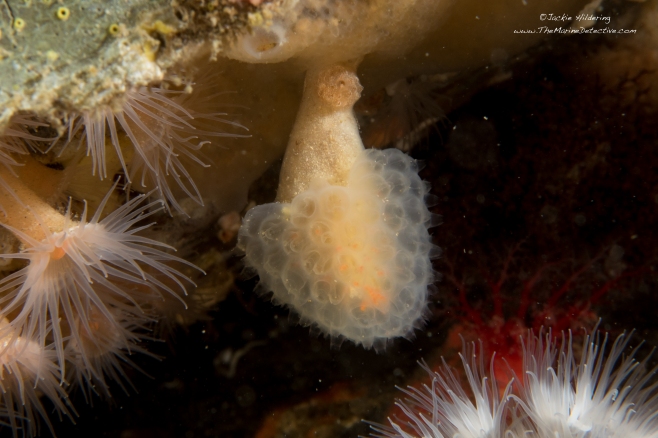
Photo shows how compound tunicate colonies share a stalk.
Tunicates are hermaphrodites where reproduction occurs both by cross-fertilization and self-fertilization. The fertilized eggs are brooded inside the colony in a brood pouch and the timing of when parents hatch out the relatively large tadpole-like larvae has been found to be influenced by light (morning appears to be preferred).
Some species of tunicate have been found to have bacteria associated with them that provide chemicals that ward off predators and disease-causing microorganisms. You can imagine the human interest in how these chemicals might help our species fight off pathogens.
And in case this all isn’t wild enough, colonial species of tunicate are known to regenerate their entire body from a group of cells named blood cells. This too makes them of great interest to we humans, who are tunicates’ distant relatives, but evolved to NOT be able to regenerate body parts.

Further information from Dr. Laura Cole, from her much-valued resource “Tunicates — Not So Spineless Invertebrates”
The most common tunicates are sometimes called sea squirts because when touched or alarmed by a sudden movement, their muscles contract and the water in the animal shoots out. They are sessile after their larval stage, meaning that they remain attached to a hard substrate, such as dead coral, boat docks, rocks or mollusk shells, all of their adult lives. The name “tunicate” comes from their outer covering, called the tunic, that protects the animal from predators, like sea stars, snails and fish. Unlike the sessile sea squirts, other kinds of tunicates float in the water their entire lives. The salps and pyrosomes are mostly transparent tunicates that look a bit like jellyfish floating freely—some pyrosomes have be known to reach 60 feet (18 m) in length. Much smaller but still visible to the naked eye are the larvaceans—tiny tadpole like creatures that live inside a small house that they build and regularly replace.
[Note there are two related The Marine Detective blogs: (1) “Pyrosomes! Say What?” at this link and (2) “Otherworldly Drifter. Mind Blown” at this link.]
What unites these diverse groups and makes them our relatives? All animals in the Phylum Chordata have a notochord, a flexible backbone like structure, at some point in their lives.

Sea squirts have a notochord only in the larval stage which they use to swim and find an ideal place to attach—one that is bathed in particle-rich waters, since like all tunicates they are filter feeders and rely on water currents for food and nutrients. Once a good location is found, the larva attaches with a suction-like structure and metamorphosis begins. The notochord shrinks and gets absorbed into the body as the animal changes into an adult, and the tunic forms as the transformation occurs. The animal will then spend its days feeding on tiny particles from the water, primarily bacteria.
There are two types of sea squirts: solitary and colonial. The solitary animals live separately all of their lives inside of their tunics. Each has two siphons—the oral siphon that receives the nutrient rich current and the atrial siphon that excretes the waste. Colonial species share a common tunic and sometimes also share the atrial siphon. Colonies of sea squirts are formed as a result of budding—when the larva settles and changes into the adult form, it then splits (or buds) to produce new individuals, called zooids. Colonies can be a few centimeters to several yards wide depending on food availability and predation.
Sea squirts don’t look much like us as adults on the outside, but they have a digestive system similar to ours—with an esophagus, stomach, intestines and a rectum. But there are plenty of other differences. Unique to the benthic tunicates is a heart that reverses its beat periodically. It’s still a mystery to researchers why the tunicate heart will circulate blood through the heart in one direction and then switch to the opposite direction, or if the ability gives them some sort of advantage.
On land, we don’t encounter sea squirts that often, although they are increasingly eaten by some Mediterranean, Asian and South American countries. Not only is the soft body inside of the tunic eaten, but the tunic itself can be pickled and enjoyed later. Compounds from several tunicate species could be useful in medical treatments for diseases ranging from cancer to asthma. Tunicates act as ocean purifiers, since they consume bacteria, and they can send a message that heavy metals are present in ecosystems where they are found, since they absorb metals like zinc and vanadium. Because they like to attach to hard surfaces, sea squirts are often found on the underside of boats, or inside motors, where they can wreak havoc on equipment, and some have become invasive species after being transported from their native ranges. Their relatives the pyrosomes, also called sea pickles, sometimes wash up in large numbers on the shore and are known for their bioluminescence.
Like with many a large family, most of us don’t know about these distant relatives found in the ocean, but that doesn’t mean they aren’t worth keeping an eye on.”
Photos of other species of tunicate living in the NE Pacific Ocean.
Note that there are many more species than what I show here.




Ciona savignyi to 15 cm tall.

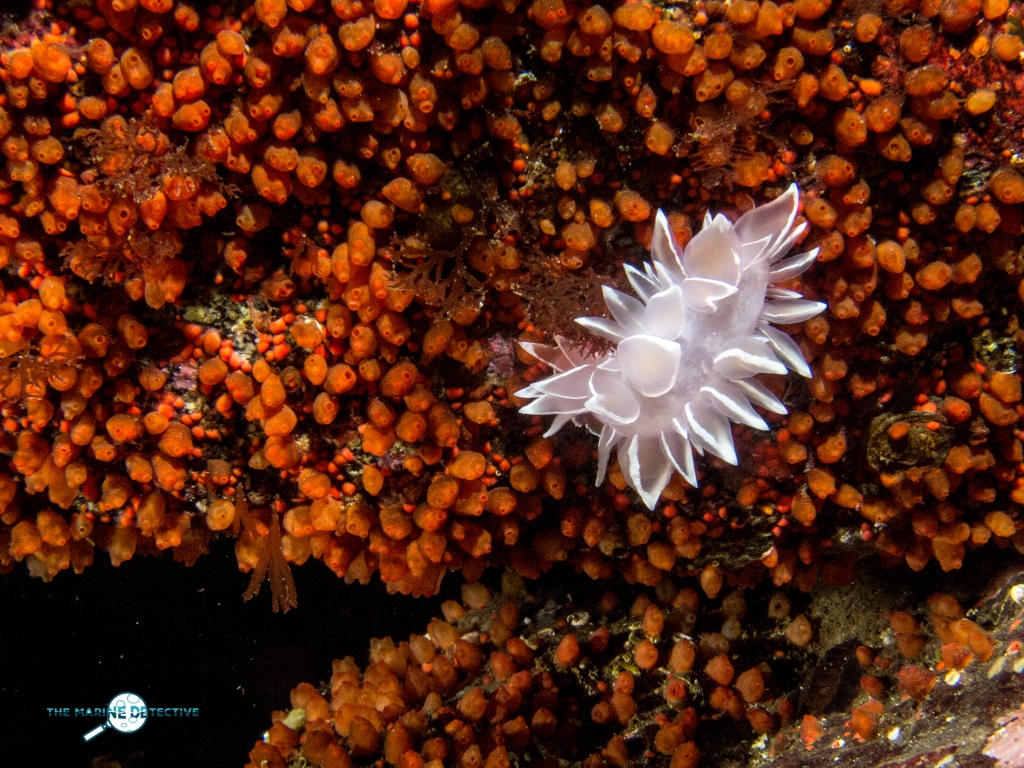

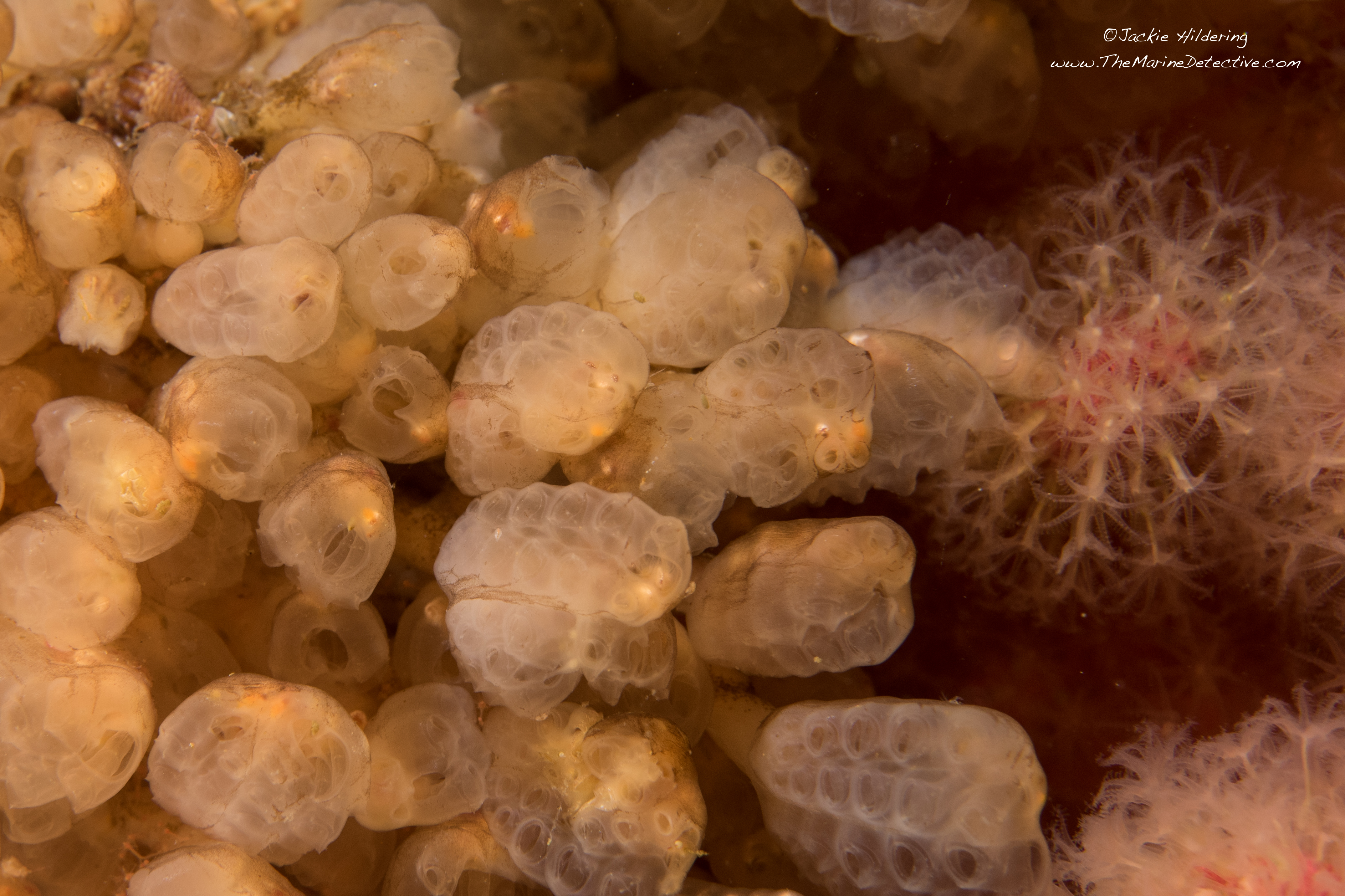
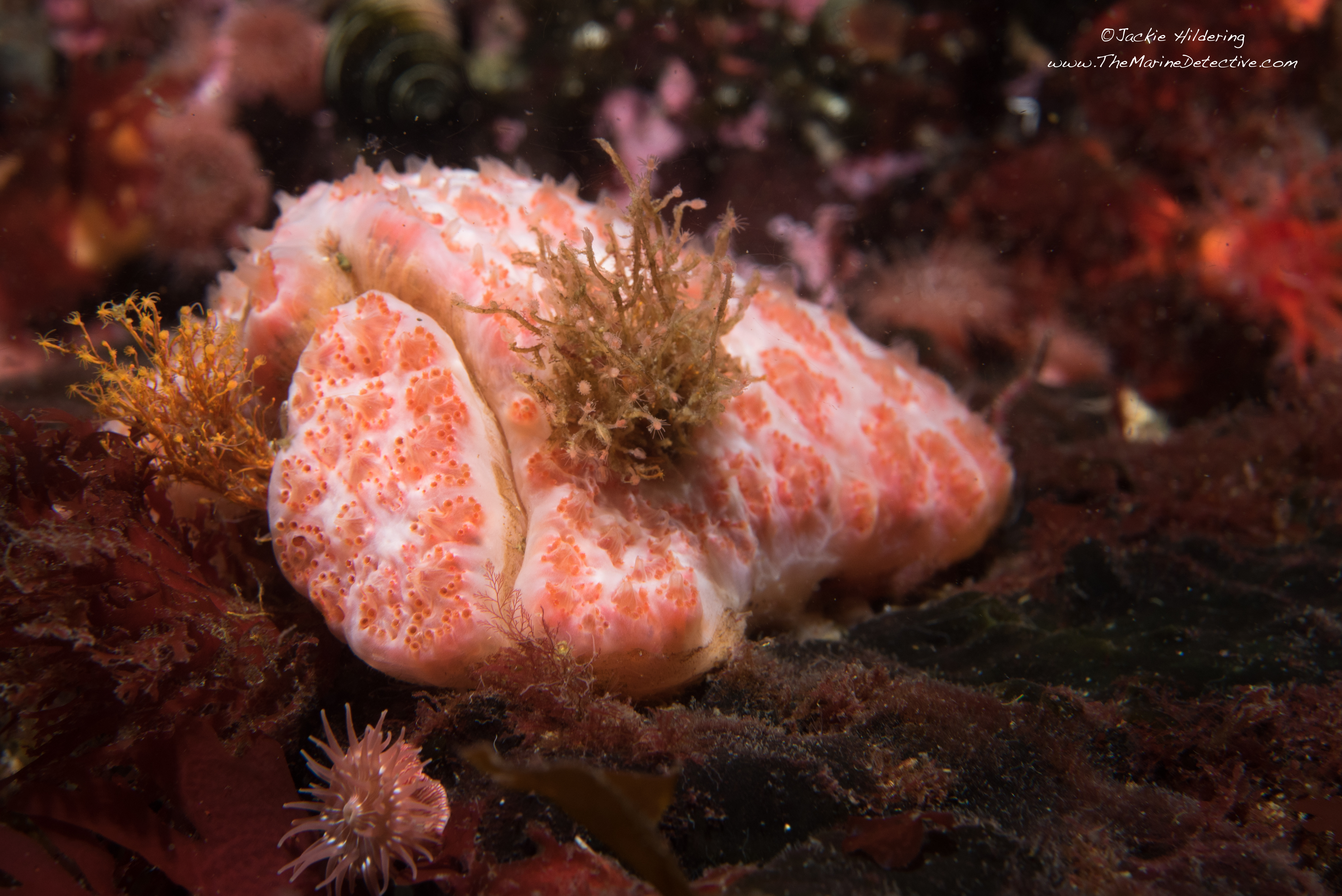
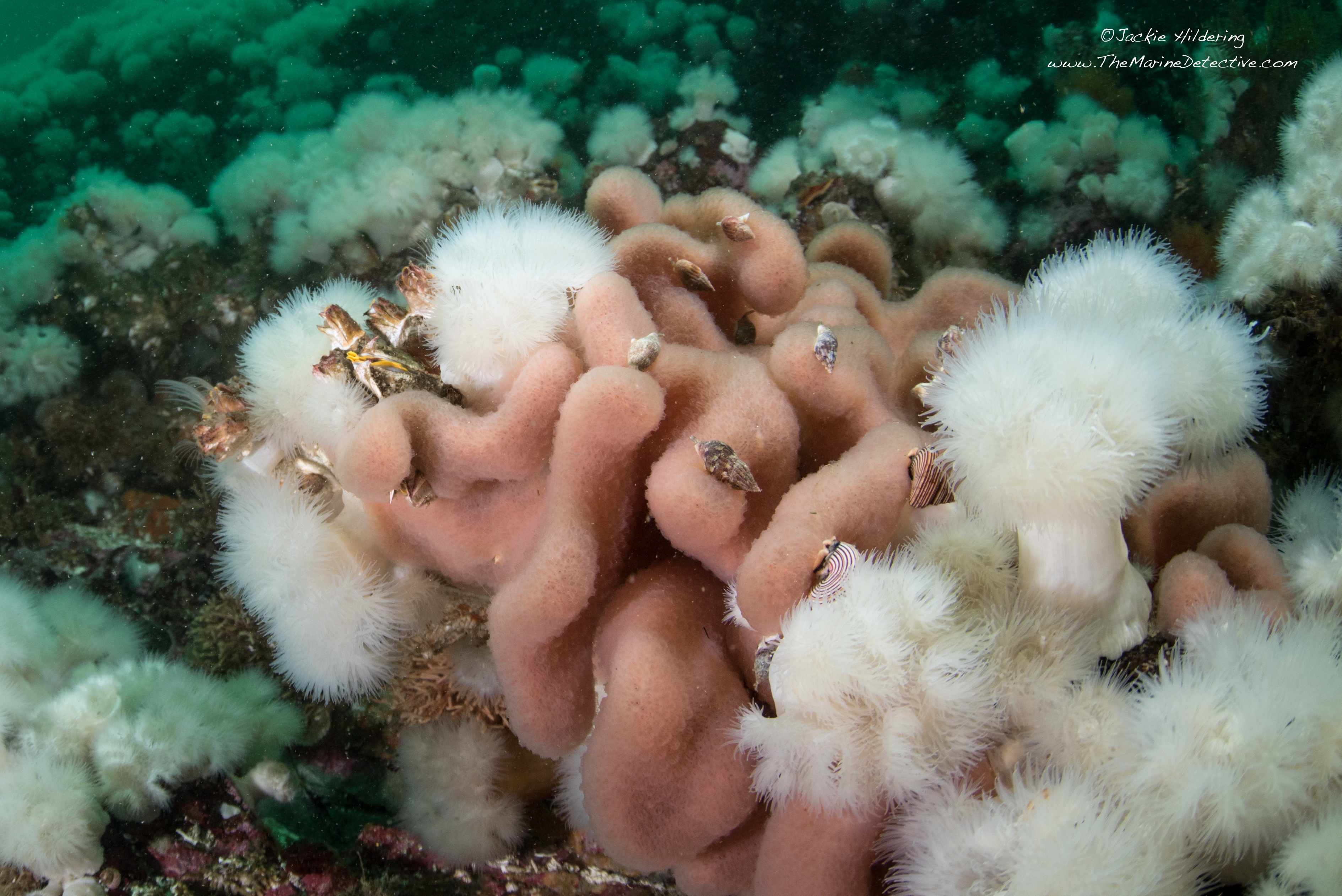

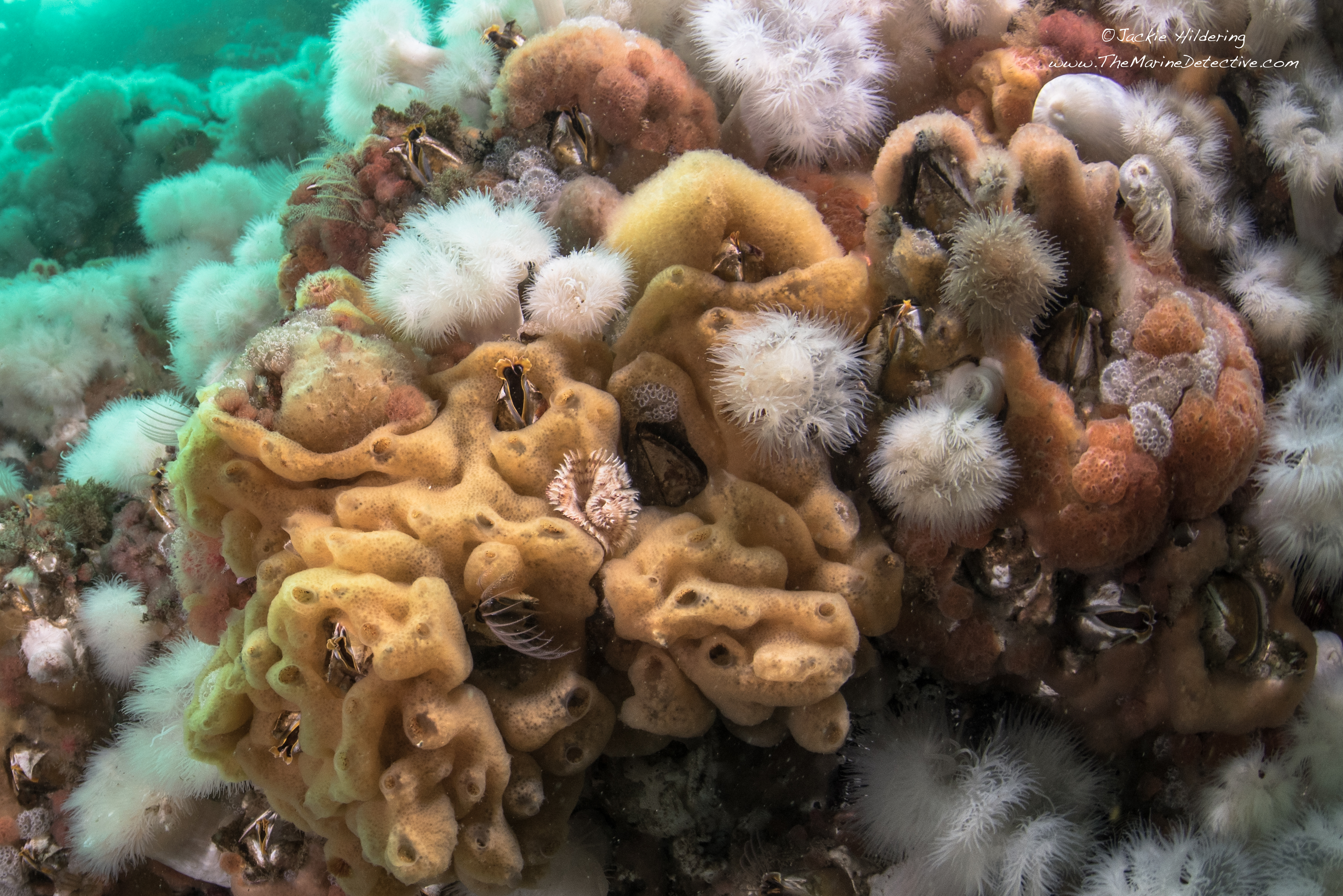

Sources:
- Current Biology: Primer on Tunicates
- Gross L (2007) From One to Many and Back Again: A Systemic Signal Triggers Tunicate Regeneration. PLoS Biol 5(4): e98.
- Snail’s Odyssey: Learn About Sea Squirts: Predators & defenses
- Smithsonian: Tunicates — Not So Spineless Invertebrates
- Washington Department of Education: “What’s a Tunicate”
Invasive Tunicates

It’s the Lined Compound Ascidian, Botrylloides violaceus. All the other species shown here are not invasive
3 Responses to “Tunicates – Your Distant Cousins?”
Wow this is all so amazing. I love the textures and colours, but also the intricacies of their daily lives. I have only seen the orange broadbase tunicates in my snorkels around Pender Island. Diving is definately a whole new dimension.
These are amazing! They can do so many worthwhile things it seems. Although I have been around and in the ocean all my life, I can’t recall seeing them. I will look more carefully in the future although it seems they can present in many different “bodies” as such including all the colours and sizes. But with this great information I should now be able to see them. Thanks, Jackie, and Dr Cole!
Really value the comment Beth. Warm wishes to you.